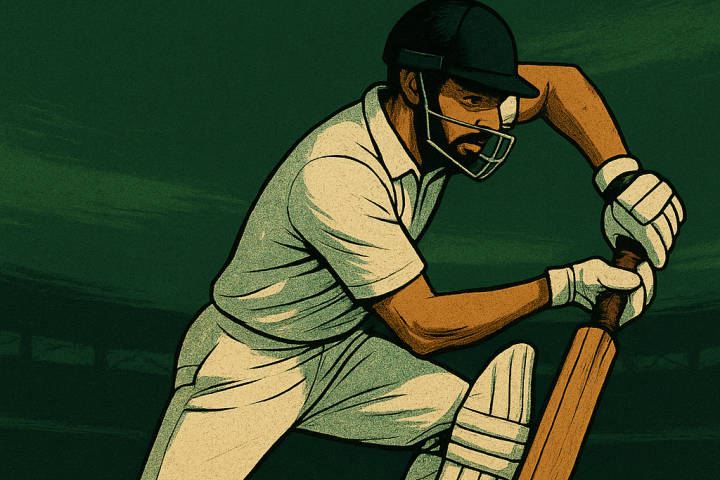How the Weather Affects Cricket Matches and Schedules
Cricket is a sport deeply influenced by weather conditions. Unlike indoor games, cricket is played in open fields, making it highly susceptible to weather fluctuations. Factors such as temperature, humidity, wind, and precipitation can all play a critical role in determining match outcomes. From scorching heat exhausting players to sudden rain disrupting gameplay, weather conditions influence every aspect of cricket. Moreover, extreme weather conditions can lead to match cancellations or postponements, affecting tournament schedules. Let's explore how different weather elements affect cricket matches, player performance, and scheduling in greater detail.
1. Rain: The Biggest Disruptor in Cricket
Rain is the most common weather condition that interrupts cricket matches, affecting everything from player performance to the overall match outcome. Unlike some other sports that can continue in the rain, cricket matches are often delayed or even abandoned due to wet pitches and unsafe playing conditions. Heavy rain can cause the outfield to become waterlogged, making it difficult for fielders to move quickly and increasing the risk of injuries. Additionally, a damp ball becomes harder to grip, affecting both bowlers and fielders. Grounds with poor drainage systems can experience extended delays, leading to frustration among players and fans alike. To mitigate such disruptions, many international venues now employ advanced drainage technology and super soppers to clear excess water quickly.
Effects of Rain on Cricket:
- Match Delays & Abandonment: Excessive rain can wash out a game, leading to a draw or reduced overs (Duckworth-Lewis method used in limited-overs cricket).
- Pitch Conditions: A wet pitch becomes unpredictable, affecting both bowlers and batsmen.
- Swing Bowling Advantage: Overcast and damp conditions provide fast bowlers with extra swing, making batting more challenging.
- Reduced Visibility: Heavy rain and overcast conditions can make it difficult for batsmen to spot the ball, increasing the chances of dismissals.
- Outfield Slowness: A wet outfield slows down the ball, reducing the effectiveness of aggressive batting and limiting boundary-scoring opportunities.
➡️ Upgrade your cricket gear with our exclusive discounts on Cricket Gear!
2. Heat & Humidity: Draining the Players
Hot weather and high humidity levels can be physically exhausting for players, impacting their stamina, concentration, and overall performance. Cricket matches played in extreme heat require players to take extra precautions to avoid dehydration and heat-related illnesses. Bowlers, particularly fast bowlers, face additional challenges as prolonged exposure to high temperatures drains their energy and affects their bowling speed and accuracy. Batsmen also struggle with grip issues due to excessive sweating, which can lead to mistimed shots and more frequent dismissals. Team strategies often include additional hydration breaks and rotating bowlers to maintain effectiveness throughout the game.
Effects of Heat on Cricket:
- Dehydration & Fatigue: Players need to stay hydrated to maintain their energy levels and avoid heat exhaustion.
- Batting Conditions: Dry and hard pitches generally favor batsmen as the ball comes onto the bat nicely.
- Spin Bowling Advantage: Dry pitches help spinners get more turn, making batting challenging in longer formats.
- Sweaty Hands & Grip Issues: Excessive sweating can cause batsmen to lose grip on the bat, leading to mistimed shots and an increased chance of getting out.
- Reduced Stamina for Fast Bowlers: The extreme heat takes a toll on fast bowlers, making it difficult to maintain speed and accuracy over extended spells.
➡️ Find the best deals on cricket bats for beginners at Cricket Bats!
3. Wind: A Bowler’s Best Friend
Strong winds can have a significant impact on cricket matches, influencing the movement of the ball and requiring players to adjust their strategies accordingly. Fast bowlers often benefit from strong gusts, as the wind aids in generating extra swing, making it more challenging for batsmen to judge the ball’s movement. Spinners, too, can use the wind to drift the ball, deceiving batsmen in flight. However, wind can also create difficulties for fielders, especially those positioned in the deep, as high winds can alter the trajectory of the ball in the air, making catching more challenging. Batting against the wind can be tricky, as mistimed shots may not travel far, while hitting with the wind can allow batsmen to clear the boundary more easily. Teams need to be aware of these conditions and adjust their game plans to maximize their advantage.
Effects of Wind on Cricket:
- Swing Bowling Enhancement: Wind can help seamers generate more swing, making it harder for batsmen to judge deliveries.
- Fielding Challenges: High winds make catching difficult, especially for outfielders, as the ball can change direction mid-air.
- Strategy Adjustments: Teams often switch bowling ends strategically to take advantage of wind direction.
- Spin Bowling Drift: Spinners can use the wind to generate extra drift and deception, making their deliveries harder to play.
- Batting Difficulties & Advantages: Batsmen hitting against the wind may struggle to clear the field, whereas those hitting with the wind can easily send the ball over the boundary.
➡️ Shop for high-quality, affordable cricket training equipment at Cheap Cricket Equipment!
4. Cold Weather: A Challenge for Players
Playing cricket in cold weather presents unique challenges for players, affecting both their physical performance and overall gameplay. Chilly temperatures can lead to muscle stiffness, reducing flexibility and increasing the risk of injuries such as strains and cramps. Bowlers, especially fast bowlers, may find it difficult to maintain their usual speed and rhythm due to restricted muscle movement. Batsmen also face difficulties as the cold weather makes it harder to grip the bat, impacting shot execution. Additionally, colder conditions can cause the ball to feel harder upon impact, making it uncomfortable for players, especially wicketkeepers and fielders handling fast catches. The mental aspect of the game is also affected, as players must battle discomfort and focus on their performance despite freezing conditions.
Effects of Cold Weather on Cricket:
- Muscle Stiffness: Cold conditions can lead to slower reflexes and increased injury risk.
- Swing Bowling Boost: The ball tends to move more in the air in cooler temperatures.
- Lower Crowd Attendance: Spectators may avoid matches in extreme cold, affecting stadium atmospheres.
- Grip & Batting Challenges: Batsmen may struggle to maintain a firm grip on the bat, leading to mistimed shots.
- Ball Hardness & Discomfort: The ball feels harder in cold weather, making it more challenging for fielders and wicketkeepers to take clean catches.
5. How Weather Impacts Cricket Scheduling
Major cricket tournaments take weather conditions into account when planning schedules. Countries with frequent rainfall, such as England and Sri Lanka, often have reserve days for important matches to ensure fair competition and minimize disruptions. The Indian Premier League (IPL) and other leagues schedule matches in the evenings to avoid excessive heat, ensuring better playing conditions and higher audience engagement. Additionally, tournaments like the ICC Cricket World Cup carefully select host venues based on historical weather data to mitigate the risk of interruptions. Some leagues even consider implementing covered stadiums or advanced drainage systems to handle unexpected downpours efficiently.
Conclusion: Be Ready for Any Weather!
Weather conditions can significantly impact cricket matches, player performance, and even tournament outcomes. Factors such as rain, heat, wind, and cold can change the dynamics of the game, influencing batting, bowling, and fielding strategies. Whether you're a professional cricketer or just a weekend warrior, having the right gear is essential to adapt to different conditions and maintain peak performance. From moisture-resistant gloves for rainy days to lightweight clothing for hot weather, choosing the right equipment can make a big difference on the field.
➡️ Visit Cricket Discounts today and save big on your next cricket purchase!
If You Want to Read More Blogs about Cricket You Can!Click Here
If You Want to Read More Blogs about Cricket News and Updates You Can! Click Here
If You Want to Read More Blogs about Cricket Gear Guides You Can! Click Here
If You Want to Read More Blogs about Cricket Tips and Tricks You Can! Click Here
If You Want to Read More Blogs about Product-Focused Blogs You Can! Click Here
If You Want to Read More Blogs about Sales and Offers You Can! Click Here
If You Want to Read More Blogs about Fitness and Training for Cricketers You Can! Click Here
If You Want to Read More Blogs about History and Fun Facts About Cricket You Can! Click Here








Leave a comment